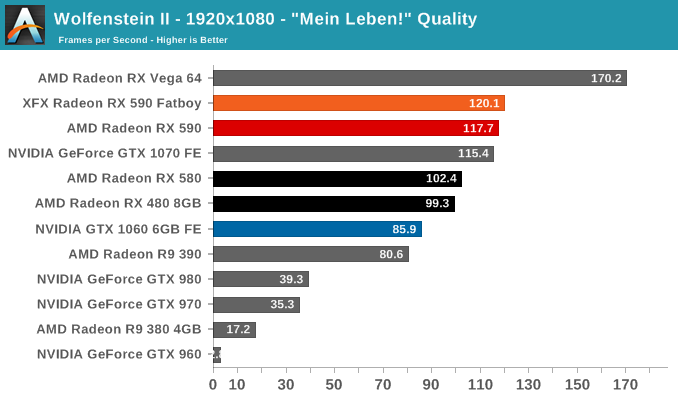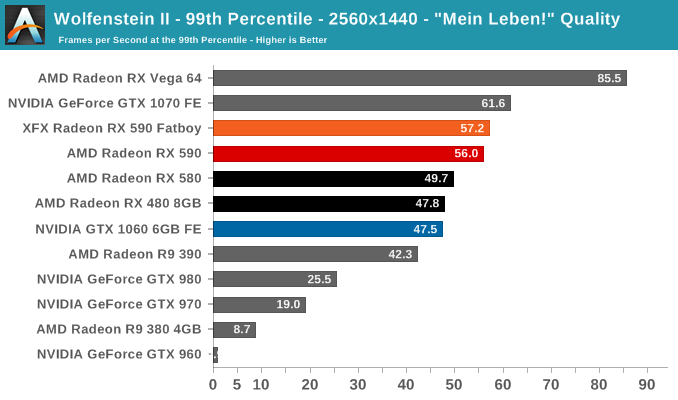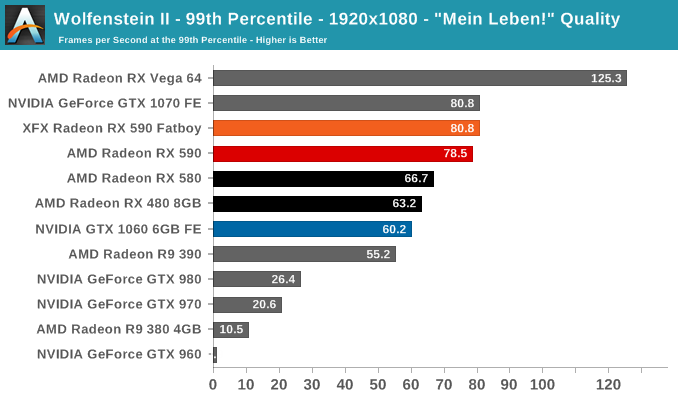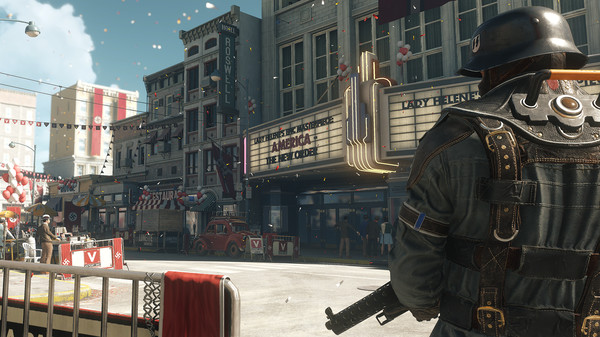The AMD Radeon RX 590 Review, feat. XFX & PowerColor: Polaris Returns (Again)
by Nate Oh on November 15, 2018 9:00 AM ESTWolfenstein II: The New Colossus (Vulkan)
id Software is popularly known for a few games involving shooting stuff until it dies, just with different 'stuff' for each one: Nazis, demons, or other players while scorning the laws of physics. Wolfenstein II is the latest of the first, the sequel of a modern reboot series developed by MachineGames and built on id Tech 6. While the tone is significantly less pulpy nowadays, the game is still a frenetic FPS at heart, succeeding DOOM as a modern Vulkan flagship title and arriving as a pure Vullkan implementation rather than the originally OpenGL DOOM.
Featuring a Nazi-occupied America of 1961, Wolfenstein II is lushly designed yet not oppressively intensive on the hardware, something that goes well with its pace of action that emerge suddenly from a level design flush with alternate historical details.
The highest quality preset, "Mein leben!", was used. Wolfenstein II also features Vega-centric GPU Culling and Rapid Packed Math, as well as Radeon-centric Deferred Rendering; in accordance with the preset, neither GPU Culling nor Deferred Rendering was enabled.


For a game that scales well and enables high framerates with minimal CPU bottleneck, Wolfenstein II has the tradeoff of needing more than 4GB at highest quality settings. This even applies to 1080p! Limited VRAM truly bottlenecks the GPU here, where a card like the enthusiast-grade GTX 980 (4GB) would typically hold its own against the mainstream-grade GTX 1060 6GB.
And so NVIDIA's historical stinginess with video memory hurts them hard here, hammering Maxwell 2 performance as only the GTX 980 Ti and above have more than 4GB of VRAM. The 2GB GTX 960 is reduced to a stuttering fit. Meanwhile, the Hawaii refresh R9 390, whose 8GB memory configuration upgrade was laughed at in 2015, has the last laugh in Wolfenstein II.
Usually, games that devour excessive VRAM have no real reason to do so other than being poor console ports. But the way Wolfenstein II runs on Vulkan has continually impressed me on many levels. It removes so much of the CPU bottleneck and truly enables usage of ultra high refresh rates at any resolution and for a bonafide AA/AAA title. The equally high 99th percentiles are perfect for VR purposes or silky-smooth 'just works' gaming, because regardless Wolfenstein II is a good-looking game. The game and engine also takes a liking to Turing, Vega, and Polaris based cards. If the VRAM consumption is not merely a correlation or coincidence, then that's a perfectly acceptable tradeoff to me.
The spare performance leaves multiple opportunities, too, and as a naive example I wonder if it'd be possible to implement something like DXR accelerated real-time raytracing at 4Kp60.













136 Comments
View All Comments
deksman2 - Friday, November 16, 2018 - link
It would be an unfair comparison because AMD is using GLOFO 12nm LP node designed for low clocks and mobile parts, whereas NV is using TSMC 16nm high performance process designed for high clocks and efficiency.You can't compare the two back to back and NV would still win in such a situation.
But, for the sake of argument, a Polish website (at least I think it was Polish) apparently managed to undervolt RX 590 just recently and total power consumption dropped by 34W.
Here's the website:
https://pclab.pl/art79190-20.html
Polaris power consumption problems stem from a combination of problems:
1. (and this would be the biggest) GLOFO 14nm/12nm process nodes designed for low clocks and mobile parts (not worth it even raising frequencies on 12nm because as we saw, both Ryzen+ and Polaris were already boosting WAY past the GLOFO node 'comfort zone' to the point efficiency was thrown out the window.
2. lower yields on GLOFO nodes contributed towards lack of voltage optimisation resulting in higher maximum voltages on GPU's shipping from factory.
3. Excessive amount of compute hardware. Polaris has powerful compute which is not really used in games, and this hardware does suck up a lot of power, and Polaris in general has about 40% more stream processors than Pascal has CUDA cores.
Kurosaki - Friday, November 16, 2018 - link
I still don't see any incitement to upgrade from my 290X, sad in a way.. : /eva02langley - Friday, November 16, 2018 - link
Vega 56 if they are on sale for the right price...However yeah, no reason to change.
The_Assimilator - Friday, November 16, 2018 - link
*sound of dead horse being beaten*Santoval - Friday, November 16, 2018 - link
How long will AMD keep squeezing the blood out of Polaris? They have practically abandoned their GPU division, their mainstream one anyway. A single refresh could be occasionally justified, but a refresh-squared of the same GPU (or GPU series) equates with rebranding.I realize that they overwhelmingly focused on their CPU and APU division in order to compete with Intel, and that drew resources and engineers from the GPU division. But competition is required in the GPU market as well, or else Nvidia will keep charging an arm and a leg for their graphics cards.
samal90 - Friday, November 16, 2018 - link
you didn't mention in the Wolfenstein 2 page, that the RX590 performs like a GTX 1070. It's an interesting observation that should be investigated.deksman2 - Friday, November 16, 2018 - link
Probably because the game is well optimised for AMD hardware (a situation which is all too uncommon).But AMD's main problems stem from using an inefficient GLOFO nodes.
14nm and 12nm were both designed for low clocks and mobile parts... this is why we see massive increase in power consumption for Polaris at high frequencies... because the GPU is clocked WAY past the voltage comfort zone where it would be efficient.
TSMC nodes are designed for high clocks and efficiency... and as such, they WILL have an advantage in clocks and power consumption.
DominionSeraph - Friday, November 16, 2018 - link
Does this win the award for most pointless launch of all time? Anyone who was in the market for a GTX 970/1060 class GPU in the GTX 970/1060 price range probably bought a GTX 970 or GTX 1060 already. Releasing a more power hungry card over 4 years late doesn't really seem like it's going to move the market.When Nvidia was 6 months late with the housefire GTX 480 they at least had the performance crown compared to the 5870. This is 4 years late and has nothing.
spdfreak - Saturday, November 17, 2018 - link
Seems like a used RX 480 8GB is probably the best value out there for 1080 gaming. Plenty of them for about 100.00 on ebay. I keep looking for the price of 1060 6GB cards to come down now that there is a glut of them, but they stay stubbornly high.neblogai - Sunday, November 18, 2018 - link
RX570s are about as fast as RX480, but start at ~$150. They are new, come with warranty, and with 2 AAA games which can be considered to be worth ~$120 if you want them, or ~$60 for reselling. RX570 is a better deal.